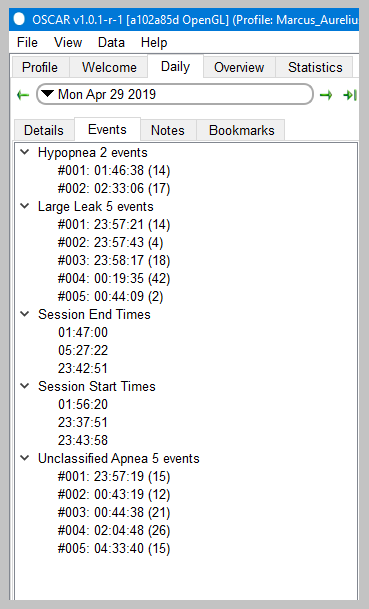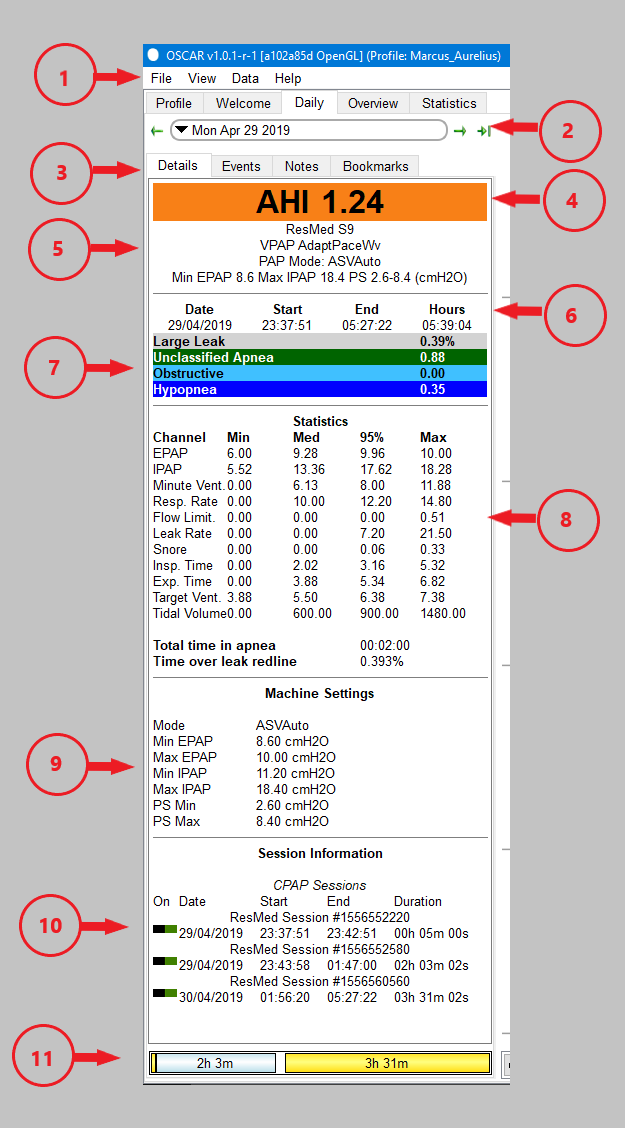OSCAR Organization - Daily Page
|
Afrikaans /
في الصفحة /
български /
中国 /
臺灣 /
čeština/
Dansk /
Deutsch /
Ελληνικά /
Español /
Filipino /
Français /
עברית /
Magyar /
Italiano /
日本語 /
한국어 /
Nederlands /
Norsk /
Polskie /
Português /
Română /
Pусский /
Suomalainen /
Svenska /
ภาษาไทย /
Türkçe |
Introduction
- This guide is part of the suite of OSCAR help articles. See OSCAR Help.
- This page explains in detail the OSCAR Daily screen.
- Acknowledgement: Much of the material on this page has been sourced from [RobySue's Beginner's Guide to SleepyHead]
Left side-bar
The Calendar
Pie Chart
Tabs: Details, events, notes and bookmarks

|
|

|
Bookmarks are created using the [bookmark tab] on the daily page:
You can add text to a bookmark:
Reviewing bookmarksIn the [right sidebar] click on the Bookmarks button at the bottom of the sidebar. The sidebar will show a list of all the bookmarks which have been created. To go to a particular bookmark, click on the date. OSCAR will open the daily page at that particular date. You can then click on a bookmark and OSCAR will adjust the display to show the event which has been selected. You can search for particular text in your bookmarks using the search window at the top of the sidebar (under the word Bookmarks). Deleting bookmarksIn the Daily page, select the bookmark you wish to delete, then click "Remove Bookmark" at the bottom of the panel.
|
The daily detailed graphs
The main part of the daily page is given over to the detailed graphs. These allow you to inspect all the important things which happened during the night, right down to a breath-by-breath review.
Common features of detailed graphs
Each daily graph chart has a number of features in common:
- Turn graphs on or off: You can turn individual graphs on and off using the chart selector at the bottom right corner of the chart area. Click on the selector and a small menu will pop up, listing all the available graphs. Click on any one to turn it on or off. When turned on, the item will show a small green & black icon. If turned off, it will show a red and black icon. The available graphs will depend on your machine, and on settings in the preferences dialog.
- Zoom level: The default view shows the whole night's chart compressed onto a single panel. You can zoom in and out for a closer view as follows:
- Left click anywhere on a graph;
- Right click anywhere to zoom out;
- Place the cursor on a graph, hold the Ctrl button and rotate the scroll wheel;
- Use the keyboard Up Arrow to zoom in and the Down Arrow to zoom out;
- To zoom out to the full view you can also right click on any graph title and select "100% zoom level". Alternatively press and hold the Escape (Esc) key or Down Arrow on your keyboard for a couple of seconds.
- Time scale: Along the bottom of each graph is a time scale to show when events occurred.
- Pin chart in position: Double-click on the title of a graph to pin it in position. Once pinned, the graph will appear at the top of the screen and will not scroll with the other graphs.
- Resize chart: You can change the vertical height of any graph by clicking in the divider line and dragging it up or down.
- Pop out chart: Right click on the graph label and select "Popout graph". A copy of the graph will be created in its own window, which can them be placed anywhere on the screen. If you pop out more than one graph, they will share a common window.
- Clone graph: Right click on the graph label and select "Clone graph". A copy of the graph will be created below the original. The cloned graph can be zoomed independently of all other graphs. To remove the clone, right click on the title and select "Remove clone".
- Reset graph layout: If you have changed the vertical height of one or more graphs, double click on a graph title and select "Reset graph layout". All graphs will be restored to their normal height.
- Y Axis: If you want to change the vertical scale of a graph, right click in the label of a graph and select "Y axis". A small pop-up will show, and give the options Autofit, Defaults and Override. Select override, the adjust the minimum and maximum numbers until the trace on the graph is to your liking. Note that you must keep the mouse cursor within the pop-up - if it strays outside, the pop-up will disappear.
- CPAP overlays: OSCAR can include a marker for each of the events on any of the graphs. Right click the graph title and select 'CPAP Overlays'. A pop-up will appear, allowing you to turn on or off each type of event. The events will appear as a short tick along the top of the graph.
- Oximeter overlays: If you have a pulse oximeter synched to OSCAR you can display certain parameters using the oximeter overlay option.
- Dotted lines: OSCAR will display dotted lines across a graph to aid in reading it. The available lines will vary depending on the particular graph. Right click on a graph title and select "Dotted lines". A pop-up will appear, with a list of available lines which you can turn on or off.
Event Flags
The event flags graph normally appears at the top of the stack. It shows each event (apnea, hypopnea, large leak etc) as a vertical bar. You can select which events to display using the event flag selector at the bottom left of the chart area. The available flags will vary depending on your machine. The graphical display of events is useful in determining whether they occurred at a particular time, in clusters or spaced through the night.
Each event type in the event flags graph will have a corresponding entry in the side bar summary area.
Flow Rate
This graph is probably the most used in analysing and interpreting CPAP data. It shows airflow in and out of your lungs throughout the night. Flow above the zero line is inhalation and below the line is exhalation. The events are shown on this graph as well as on the event flags graph. You can zoom in to examine an event more closely.
Placing the cursor on any event will create a small pop-up detailing the type and duration of the event in seconds.
Pressure and Mask Pressure
The pressure graph shows the pressure as it varies over time. The mask pressure graph shows the pressure at the mask on a breath by breath basis.
Zooming in shows how the mask pressure is a high resolution chart sampled 25 times per second, while the pressure is only sampled once per second. Depending on your machine settings there may be several traces shown - usually the pressure in inhale (IPAP) and on exhale (EPAP).
Flow Limitation
Leak Rate
The leak rate graph indicates whether excessive mask leaking occurred, and to what extent. All CPAP masks are designed to leak or vent surplus air away from the user's nose or mouth. This flushes away the exhaled breath and prevents the user re-breathing his expelled CO2. The actual amount of this designed leak will vary according to the mask. Anything in excess of that amount is "additional leak".
Resmed machines show a single trace indicating the additional leak. By default (in accordance with Resmed guidelines), Oscar flags any additional leak over 24 L/min as an excessive or "large leak". You can adjust the red line between acceptable and unacceptable leaks by using File | Preferences | CPAP | Flag leaks over threshold.
Philips machines show two traces - total leak and additional leak. It is the lower additional leak line which indicates whether the leak is excessive or not.
Snore
Resmed and Philips machines both show snoring as a graph with the height of the trace indicating the intensity of the snoring. In addition, Philips machines show individual snores as events labelled VS1 and VS2 (vibratory snore 1 and 2). It is usually suggested that VS2 be turned off when presenting screen shots for discussion as the large number of events recorded can overwhelm other data on the charts.
Oximetry Data
If oximetry data and events have been imported into OSCAR:
Zeo Data
If data has been imported from a Zeo sleep monitor device, additional graphs will be available, including Sleep stage,

Donate to Apnea Board
















